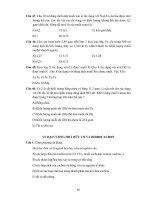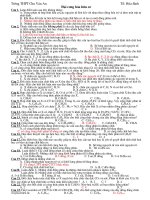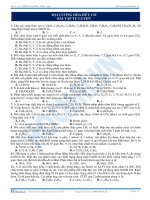Đại cương hoá Hữu cơ
Bạn đang xem bản rút gọn của tài liệu. Xem và tải ngay bản đầy đủ của tài liệu tại đây (3.12 MB, 42 trang )
Organic Chemistry
4
th
Edition
Paula Yurkanis Bruice
Chapter 1
Electronic Structure
and
Bonding
Acids and Bases
Irene Lee
Case Western Reserve University
Cleveland, OH
©2004, Prentice Hall
•
Organic compounds are compounds containing carbon
•
Carbon neither readily gives up nor readily accepts
electrons
•
Carbon shares electrons with other carbon atoms as
well as with several different kinds of atoms
Organic Chemistry
The Structure of an Atom
•
An atom consists of electrons, positively charged protons,
and neutral neutrons
•
Electrons form chemical bonds
•
Atomic number: numbers of protons in its nucleus
•
Mass number: the sum of the protons and neutrons of an atom
•
Isotopes have the same atomic number but different mass
numbers
•
The atomic weight: the average weighted mass of its atoms
•
Molecular weight: the sum of the atomic weights of all the atoms
in the molecule
The Distribution of Electrons in an Atom
•
Quantum mechanics uses the mathematical equation of wave
motions to characterize the motion of an electron around a
nucleus
•
Wave functions or orbitals tell us the energy of the electron and
the volume of space around the nucleus where an electron is
most likely to be found
•
The atomic orbital closer to the nucleus has the lowest energy
•
Degenerate orbitals have the same energy
Table 1.1
•
The Aufbau principle: electrons occupy the orbitals with
the lowest energy first
•
The Pauli exclusion principle: only two electrons can
occupy one atomic orbital and the two electrons have
opposite spin
•
Hund’s rule: electrons will occupy empty degenerated
orbitals before pairing up in the same orbital
•
Ionic compounds are formed when an electropositive
element transfers electron(s) to an electronegative
element
Covalent Compounds
•
Equal sharing of electrons: nonpolar covalent bond
(e.g., H
2
)
•
Sharing of electrons between atoms of different
electronegativities: polar covalent bond (e.g., HF)
Electrostatic Potential Maps
•
A polar bond has a negative end and a positive end
dipole moment (D) = µ = e x d
(e) : magnitude of the charge on the atom
(d) : distance between the two charges
A Dipole
Lewis Structure
Formal charge =
number of valence electrons –
(number of lone pair electrons +1/2 number of bonding electrons)
Important Bond Numbers
H F ICl Br
one bond
O
two bonds
N
three bonds
C
four bonds
The s Orbitals
The p Orbitals









